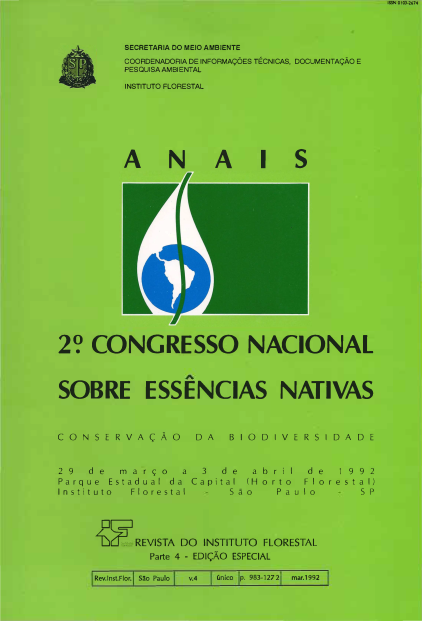RELAÇÃO ENTRE ORTETES E RAMETES DE SERINGUEIRAS ORIGINADOS DE POPULAÇÕES NATURAIS
DOI:
https://doi.org/10.24278/2178-5031.199244783Keywords:
Rubber tree, ortets, ramets, correlation, natural populationAbstract
The relation between ortets and ramets with the characteristic number of latex vessel ringswas studied at 30 cm, 60 cm and 90 cm height on stem of rubber tr~e. The objective was to identify the maintenance of this character in the ramets. It was also studied the performance of 100 ramets during two years. The bark thickness and the number of vessel rings were little influenced by the environmental conditions during the two years. The evaluation of the number of rings at 60 cm height in the stem demonstrated to be more appropriate for selecting productive ortets. The utilization of a index taking into consideration thesum ofthe ring number inthe measured heights and the standard deviation was more appropriated to identify the ramets that preserve ali the characteristics of the ortets.
Downloads
References
CRAMER, P. J. S., 1938. Grading young rubber plants with the "Textatex" knife.ln: RUBBER TECHNOLOGY CONFERENCE, London. Proceeding. London, s.ed., 1938, p.1 0-6.
HAMAKER, C. M., 1914. Plantwijdtc en vitdunning bij Hevea. In: PRAEADVIES VERSAGEN VAN HET
INTERNATIONAL RUBBER CONGRESSo s.n.t.
MANN, C. E. T., 1932. Selection and breeding. Early determination of yelding qualities of seedlings. In: RUBBER RESEARCH INSTITUTE OF MALAYA Botanical Division. Annual report, 1931. Kuala Lumpur, 1932. p.66-8.
MARQUES, J. R. B. & GONÇALVES, p.der S., 1990. Testes precoces de produão na seleção de plantas de seringueira. Pesquisa agropecária Brasileira. Brasllia, 25(7): 1065-77. .
MENDES, L. O. T., 1971. Poliploidização da seringueira: um novo teste para determinação da capacidade de produção de seringueiras jovens Polímeros, São Paulo. (1) :22-30.
MORRIS, L. E., 1932. Tapping experiments. 2. 'Test tapping young seedlings trees. In: RUBBER RESEARCH INSTITUT OF MALAYA. Botanical Division. Annual reporto 1931. Kuala Lumpur, 1932. p. 66-8.
PAIVA, J. R. de; GONÇALVES, P. de S. & GASPAROTTO, L., 1985. Variação genética entre procedências de seringueira. Pesquisa Agropecuária Brasileira, Brasília, 20(1):97-107.
PAIVA, J. R. de; TEIXEIRA, L. O. A; VALOIS, A.C. C. & GONÇALVES, P. de S., 1984. Aproveitamento dos recursos genéticosdaseringueira.ln: SIMPÓSIO DO TRÓPICO ÚMIDO, 1., Belém, PA, 1984.Anais.Belém, EMBRAPA-CPATU, 6v 105-112, 1986 (EMBRAPACPATU DOCUMENTO, 36).
TAN, H. &SUBRAMANIAN,S., 1976.Afive parentdiallel cross analysis for certain characters of young Hevea seedlings. In: INTERNATIONAL RUBBER CONFERENCE, Kuala Lumpur, 1975. Proceedings. Kuala Lumpur, v.2. p.13-6.
XU, G. Z., 1984. New dones of commercial importance in the Guangdong rubber planting region and some proposalsfor Heveabreeding In: COLLOQUE Hevea 84, Montpellier, 1984. Proceedings ...s.1., S. ed., p.437-44.















